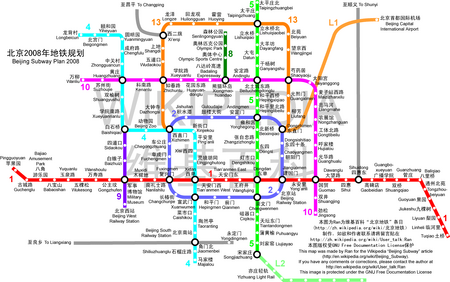The Beijing Subway, Beijing Underground or Beijing Metro (Chinese: 北京地铁 ; pinyin: Běi Jīng Dì Tiě) is a subway system that serves the greater Beijing area and its various outlying suburbs. The Beijing Subway currently has 4 lines:
- Line 1, 38 km long, from Pingguoyuan to Sihui East
- Line 2 (loop line), 16km long, most of which is beneath the 2nd Ring Road
- Line 13, 40.8 km long, from Xizhimen to Dongzhimen
- Batong Line, 18.9 km long, extends from Sihui to Tuqiao
Fares[]
The fare for Lines 1 and 2 costs 3 RMB, and transfer between these two lines at Fuxingmen and Jianguomen is free. The fare for Line 13 costs 3 RMB, and that for the Batong Line is 2 RMB. There's also a ticket valid for one transfer between Lines 1&2 and Line 13 for 5 RMB, and a ticket valid for one transfer between Lines 1&2 and Batong Line for 4 RMB.
Line 13 uses automated ticket gates, while the other lines have employees at platform entrances to check passengers for tickets. Many of the stations that are part of the older lines contain automated gates as part of an early testing phase; however, they were deemed to be inefficient and were abandoned early on.
For users of Beijing's new Yikatong transportation card, Line 13 accepts them. It is expected that the card will also be accepted on the Batong Line soon, perhaps as early as the end of 2004.
History[]
Beijing's subway system was the first such system nationwide. Construction began in 1965.
The first stretch of the Beijing Subway, from Beijing Railway Station to Pingguoyuan, opened on October 1, 1969. The line corresponds to the western section of Line 1 and the southern section of Line 2 (loop line) today. Initially, however, this line was only for official use - the system became open to the general public only in 1977.
On September 20, 1984 the rest of the loop line was opened, and the Beijing subway was henceforth operated as two lines. On December 12, 1992, Line 1 was extended eastwards from Fuxingmen to Xidan; on September 28, 1999 Line 1 was further extended from Xidan to Sihuidong. The entire passageway from Xidan through to Jianguomen was opened on June 24, 2000, thus allowing trains to go directly from Pingguoyuan to Sihuidong.
In 1988-98 and 1991-93, the subway was funded by a 20 billion yen loan from Japan.
A new line, Line 13, was opened in two sections, the western section until Huoying on September 28, 2002, and the eastern section on January 28, 2003. In the meantime, the Batong Line, built as an extension to Line 1, was opened as a separate line on December 27, 2003.
More lines are on the way: Line 5 has been under construction since December 2002, Line 10 since March 2004. Line 4 is also presently under construction.
Challenges[]
Services for the Disabled[]
At present, the Beijing subway is still partially unfit for the disabled. Services and amenities for the disabled, however, are being progressively introduced. Authorities claim completion by 2005, but the fact that some stations were built during the 1960s through the 1980s make the task daunting.
Automatic Ticket Systems[]
Presently, no lines apart from Line 13 employs Automatic Ticket Systems, and revision of stations on Lines 1 (Western) and 2 (entire loop) is difficult, as the entrances to the stations are way too narrow. Tickets on these lines are bought, instead, from subway staff. Remodelling these stations to allow for automatic systems is therefore also a daunting task.
Emergency Services[]
After witnessing disastrous subway accidents in the Republic of Korea (e.g. Daegu), Beijing authorities took prompt action in late 2003 and early 2004 and banned shops inside subway stations. Also, reflective self-illumating signs were installed in case of emergencies. Finally, the underground mall at the subway station at Xidan was closed in 2003. Despite being very popular, authorities fear that evacuation may be hampered in the case of a subway accident.
Future Projects[]
As part of the preparations for the 2008 Summer Olympics, Beijing has pledged to expand its public transportation network. The planned lines are:
- Line 5, 27.6 km long, will extend from Taipingzhuang North to Songjiazhuang. Construction started in December 2002. This is Beijing's first north-south line and runs through some important parts of the city centre. The entire line is expected to open in late 2005.
- Line 10 stretches from Huoqiying in west Beijing to Jingsong in southwestern Beijing. Construction started in March 2004.
- Line 4, will extend from Beigongmen at the Summer Palace to Majiapu.
- Olympic branch line, 5.91 km long, will extend from Xiongmaohuandao (Panda Roundabout) to Senlin Gongyuan (Forest Park), and will serve the new Olympic Park area.
- Yizhuang Light Rail, 19.5 km long, will serve the Yizhuang area to the southeast.
- Line 9, 18.3 km long. The first phase will extend from Baishiqiao to Beijing West Railway Station.
Additional lines (may or may not be complete for 2008):
- Line 9 will be extended to the Beijing World Park.
- Line 10 will be extended to Songjiazhuang.
- Three suburban lines (Xi'erqi - Changping, Gaobeidian - Shunyi and Yongdingmen - Liangxiang) are on the drawing board.
Beijing projects expansion of its subway network from the current c. 110 km to around 200 - 300 km by 2008, and over 1,000 km by 2050. The subway would be able to handle 20% of passenger traffic by 2008 (instead of less than 10% now) and would expand to up to 60% by 2050.
See also: List of Beijing subway stations
